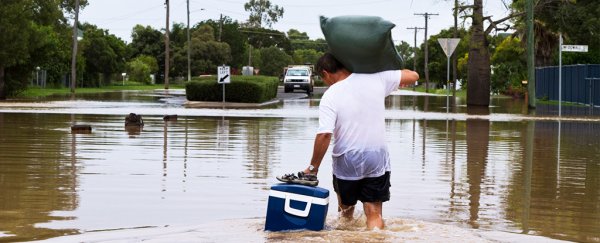The Greenland and Antarctic ice sheets are melting. Scientists have known this for years, but they're only now realising how quickly that melting is happening.
Greenland's ice is melting six times faster now than it was four decades ago; the ice sheet is sloughing off an average of 286 billion tons of ice per year.
In the 1980s, Antarctica lost 40 billion tons of ice annually. In the last decade, that number jumped to an average of 252 billion tons per year.
A new study published in the journal Proceedings of the National Academy of Sciences reports that the sea-level rise from this accelerated melting could have "have profound consequences for humanity."
The researchers found that, in the worst-case scenario – in which the planet heats up by 5 degrees Celsius (9 degrees Fahrenheit) in the next 80 years – melted ice could raise sea levels worldwide could by more than 6.5 feet.
The water would swamp major coastal cities like New York and Shanghai, displacing up to 187 million people by 2100, the authors reported.
Underestimating sea-level rise
Roughly 1.7 million square kilometers (656,000 square miles) in size, the Greenland ice sheet covers an area almost three times that of Texas. Together with Antarctica's ice sheet, it contains more than 99 percent of the world's fresh water, according to the National Snow and Ice Data Center.
Most of that water is frozen in masses of ice and snow that can be up to 10,000 feet (3 kilometers) thick. But as human activity sends more greenhouse gases into the atmosphere, the oceans absorb 93 percent excess heat those gases trap.
The warmer air and water is leading ice sheets to melt at unprecedented rates.
In 2013, the United Nations Intergovernmental Panel on Climate Change predicted that sea levels would rise by up to 38.5 inches – just over 3 feet (97 centimeters) – by 2100 if carbon emissions continue to rise unabated.
The predictions in this new study are more than double the UN's 2013 estimate.
While the chances of a worst-case scenario coming to pass are only estimated at around 5 percent, the study authors still reported it was "plausible" that global oceans would indeed rise 6.5 feet by the year 2100.
Higher sea levels could create 187 million climate refugees
If sea levels did really rise by 6.5 feet, that could result in a loss of 691,120 square miles (1.8 million square kilometers) of land, the authors of the new report said.
That's an area larger than France, Germany, Spain, and the UK combined.
In that case, major coastal cities like London, New York, and Shanghai would be threatened by extreme flooding. Small Pacific island nations like Vanuatu would be rendered uninhabitable or disappear entirely.
The study authors also said a lot of the lost land would be in "critical regions of food production" – places like the Nile River delta in Africa, according to the BBC.
In total, up to 2.5 percent of the world's current population could be displaced from their homes, the researchers added.
"To put this into perspective, the Syrian refugee crisis resulted in about a million refugees coming into Europe," lead author of the new study Jonathan Bamber told the BBC.
"That is about 200 times smaller than the number of people who would be displaced in a 2-meter [6.5-foot] sea-level rise."
Bamber told CNN that the displacement of that many people around the world would "likely result in serious social upheaval."
"It really is pretty grim," he added.
This article was originally published by Business Insider.
More from Business Insider:
